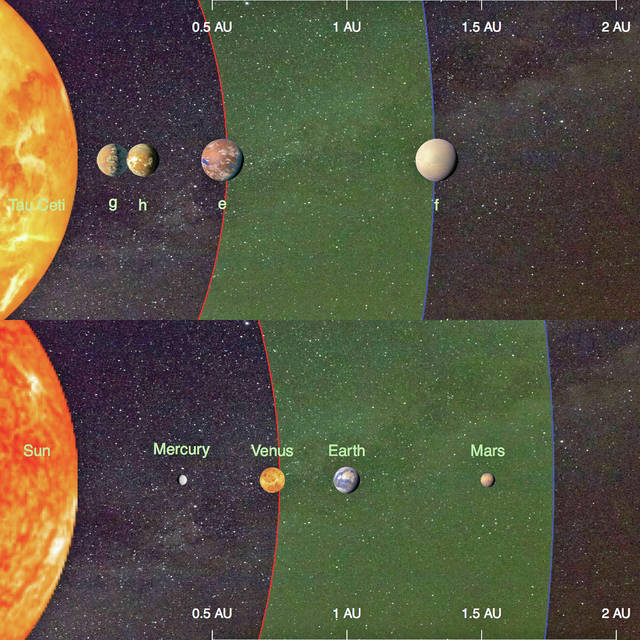WAIMEA — A new study by an international team of astronomers reveals that Tau Ceti, the nearest sun-like star about 12 light years away from the sun, has four Earth-sized planets orbiting it. ADVERTISING WAIMEA — A new study by
WAIMEA — A new study by an international team of astronomers reveals that Tau Ceti, the nearest sun-like star about 12 light years away from the sun, has four Earth-sized planets orbiting it.
These planets have masses as low as 1.7 Earth mass, making them among the smallest planets ever detected around the nearest sun-like stars. Two of them are Super-Earths located in the habitable zone of the star and thus could support liquid surface water.
The data were obtained by using the High Accuracy Radial Velocity Planet Searcher (HARPS) spectrograph at the European Southern Observatory in Chile, combined with the High-Resolution Echelle Spectrometer (HIRES) at the W. M. Keck Observatory on Mauna Kea.
“HIRES is one of only a few spectrometers in the world that have routinely delivered the level of radial velocity precision needed for this kind of work,” said co-author Steve Vogt, professor of astronomy and astrophysics at UC Santa Cruz. “And it is one of only two instruments in the world, the other being HARPS, that has been able to deliver this precision level for over a decade. It is a very unique facility in the exoplanet discovery field.”
The four planets were detected by observing the wobbles in the movement of Tau Ceti. This wobble, known as the Doppler effect, happens when a planet’s gravity slightly tugs at its host star as it orbits.
Measuring Tau Ceti’s wobbles required techniques sensitive enough to detect variations in its movement as small as 30 centimeters per second. The smaller the planet, the weaker its gravitational pull on its host star and the harder it is to detect the star’s wobble.
“We are getting tantalizingly close to the 10 centimeters per second limit required for detecting Earth analogs,” said Fabo Feng from the University of Hertfordshire in the United Kingdom and lead author of the study. “Our detection of such weak wobbles is a milestone in the search for Earth analogs and the understanding of the Earth’s habitability through comparison with these analogs.”
The outer two planets around Tau Ceti are likely to be candidate habitable worlds, although a massive debris disc around the star probably reduces their habitability due to intensive bombardment by asteroids and comets.
The same team also investigated Tau Ceti four years ago in 2013, when Mikko Tuomi led an effort in developing data analysis techniques and used the star as a benchmark case.
“We came up with an ingenious way of telling the difference between signals caused by planets and those caused by a star’s activity. We realized that we could see how a star’s activity differed at different wavelengths, then used that information to separate this activity from signals of planets,” he said.
“We have painstakingly improved the sensitivity of our techniques and could rule out two of the signals our team identified in 2013 as planets. But no matter how we look at the star, there seems to be at least four rocky planets orbiting it,” Tuomi added. “We are slowly learning to tell the difference between wobbles caused by planets and those caused by stellar active surface. This enabled us to essentially verify the existence of the two outer, potentially habitable, planets in the system.”
Sun-like stars are thought to be the best targets for searching for habitable Earth-sized planets due to their similarity to the sun. Unlike more common smaller stars such as the red dwarf stars Proxima Centauri and Trappist-1, they are not so faint that planets would be tidally locked, showing the same side to the star at all times.
Tau Ceti is very similar to the sun in its size and brightness, and they both host multi-planet systems. If the outer two planets are found to be habitable, Tau Ceti could be an optimal target for interstellar colonization, as seen in science fiction.
“Such weak signals of planets almost the size of the Earth cannot be seen without using advanced statistical and modeling approaches. We have introduced new methods to remove the noise in the data in order to reveal the weak planetary signals,” Feng said.



